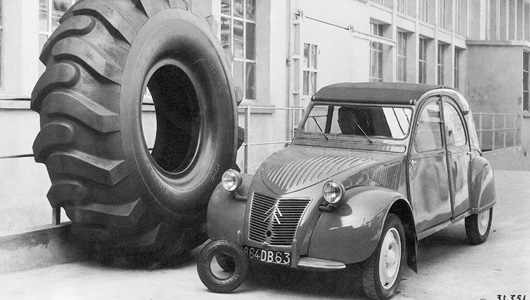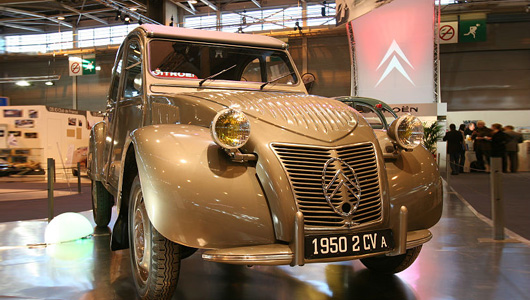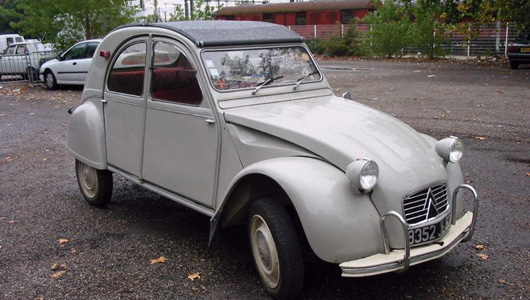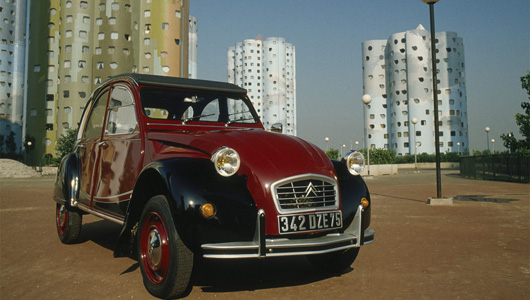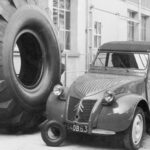The 2CV model is considered the “Ford Model T” of the French and it has also become a legend of the Citroen car company.
2CV is short for the French name “Deux Chevaux,” which means “2 horsepower,” based on the car tax scale according to horsepower rating and cylinder capacity common in Europe in the early 20th century. The first 2CV officially appeared at the 1948 Paris Motor Show, marking the start of millions of cars produced thereafter. In a short period of time, the 2CV became present on every road in Europe. It wasn’t until over 40 years later, in 1990, that Citroen stopped production of this type of car.
2CV and the shocking design
To understand more about the history of the 2CV, we need to go back to the late 1930s. In 1936, Pierre-Jules Boulanger, the man behind the famous Traction Avant, embarked on the development project of a car named TPV (“Très Petite Voiture” – Very Small Car). He was assisted by top experts such as Flaminio Bertoni and André Lefebvre. The first prototype was produced in 1937.
Unfortunately, the outbreak of World War II interrupted the car’s development process. The prototype was hidden by disassembling its parts and scattered throughout France to prevent them from falling into German hands. During that time, Pierre-Jules Boulanger continued to research and made some improvements. The testing process resumed in 1946. To keep the project a secret, Boulanger bought a piece of land in the western part of Paris, in La Ferté-Vidame, which is now Citroen’s test center.
And finally, the significant day arrived. The 2CV caused a strong shock when it was unveiled at the Paris Motor Show on October 7, 1948. The initial reactions were quite intense. The design of the car was considered shocking because it was too different from the familiar Traction Avant style. However, the most important thing was that the 2CV attracted everyone’s attention. While the press remained skeptical, the people enthusiastically welcomed the new car. Orders piled up, and the factory couldn’t keep up with the demand. Some customers had to wait for years to get their hands on the car of their dreams.
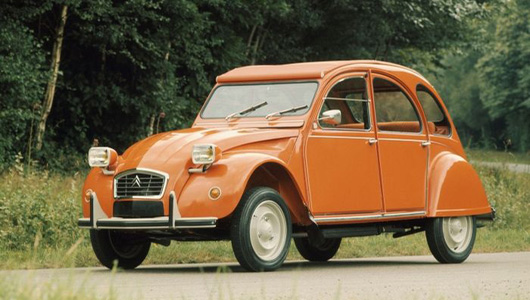 The 2CV had a revolutionary design when it was introduced
The 2CV had a revolutionary design when it was introduced
The design of the 2CV is most noticeable in the symmetrical arrangement of its doors. The front of the car is very lively, with a hood made of wavy sheet metal and a radiator grille adorned with the inverted V logo in an oval frame. All parts of the body can be easily disassembled and reassembled thanks to cleverly arranged joints and screws. The weight of the car is only 500kg, it can reach a modest speed compared to today’s standards of 65km/h, and it has a fuel consumption of 4.5 liters/100km.
With all its advantages, the 2CV turned out to be the car that Pierre-Jules Boulanger had dreamed of: small, practical, and affordable. Unfortunately, Boulanger passed away shortly after in 1950, only seeing the biggest achievement of his life taking its first wobbly steps.
Changes
The 2CV went through many changes in the 1950s. One of the important developments in 1951 was the introduction of the 2CV utility version (model AU) for transporting goods. In 1954, Citroen increased the total engine capacity to 425cc. In December 1956, Citroen unveiled the 2CV AZL model. With a large rectangular rear window and a fabric roof, the AZL was considered the premium version of the 2CV range.
In 1960, the designers decided to give the 2CV a makeover for the first time, mainly focusing on the interior design. The hood also had a new look with 5 grooves and had openings on both sides.
Another model of the 2CV was introduced at the 1961 Paris Motor Show, the 2CV AZLP. With an actual power output of 13.5 horsepower at 4,000rpm, this powerful car reached a top speed of 85km/h and consumed 5.5 liters of fuel for a long trip of 100km.
In 1964, the “Duck” underwent another transformation, this time with a revolutionary change: the doors were hinged at the front instead of the traditional rear-hinged design. With this change, the “Duck” was heading in the right direction.
The front end of the car was redesigned once again in 1966 to keep up with contemporary tastes. The radiator grille consisted of 3 horizontal aluminum bars, while the front drum brakes were covered with an additional black plastic layer. The 2CV was considered a people’s car, but above all, it was a standout car for city-dwellers.
Special editions
The 2CV was completely revamped for the Paris Motor Show in 1974, with a plastic radiator grille and rectangular headlights. The magical “Duck” still had surprises up its sleeve… Aspired to innovate while not forgetting the fans of the old style, Citroen launched a “Special” 2CV model in 1976 for traditional style enthusiasts. With round headlights, minimal interior, and an externally old-fashioned appearance, this model looked almost identical to the first 2CV produced.
The “Charleston” model sparked a series of special editions of the 2CV in 1981. With details from the 1930s: round van headlights, a deep black body, the car achieved immediate success. Shortly after its launch, the model became standard and was included in the company’s catalog starting from 1982.
The “Dolly” model was introduced in 1985, combining two solid colors such as vanille and grey, green and black, or red and grey. In 1986, the 2CV continued to maintain its position as a “car for the people” in France. The special edition “Cocorico”, with a Red-White-Blue exterior representing the French flag, vividly illustrated this position. The advertising slogan for this car was “This 2CV is really too much”.
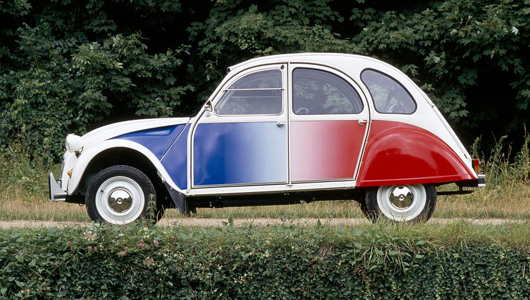 The “Cocorico” special edition
The “Cocorico” special edition
The search for fuel for cars running in areas such as deserts prompted Citroen to develop the 2CV 4×4. Each axle was powered by 2 engines, one in the front and one in the rear.
When carrying a sufficient load, the 2CV 4×4 could perform well on terrains with sand or with slopes greater than 40%, however, the rear-mounted engine limited the car’s payload. Although it was announced in March 1958, it wasn’t until 1960 that this type of car was actually put into production. By 1966, Citroen had produced 694 2CV 4×4 cars.
Thế Đạt (According to PL&XH/ Source: Tổng hợp)
Introducing Citroen’s CV2: Discover the “Duckling”
The 2CV car model has often been compared to the French version of the “Ford Model T” and is widely regarded as a symbol of French design and engineering excellence. Its distinctive and unique appearance makes it a standout on the road, turning heads wherever it goes. Renowned for its simplicity, durability, and affordability, the 2CV has earned a special place in the hearts of car enthusiasts and collectors worldwide. It is not just a car; it is a testament to the innovative and creative spirit of the French automotive industry, representing a rich cultural heritage. Don’t settle for the ordinary when you can experience the extraordinary with the 2CV.






























